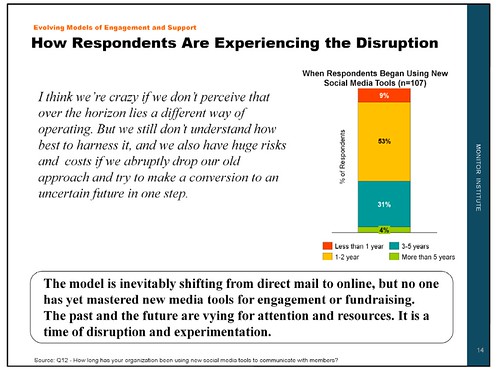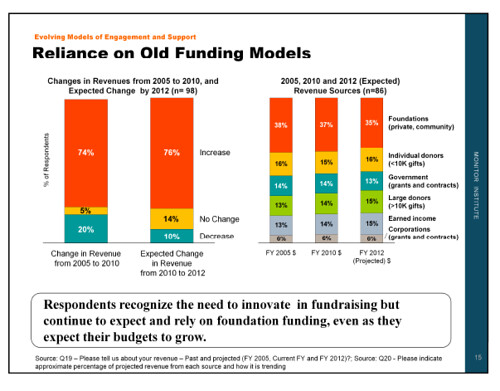My colleagues at The Monitor Institute just published a study called “Disruption: Evolving Models of Engagement and Support,” a national study of member-based advocacy organizations. The study was funded by the David and Lucile Packard Foundation, The John S. and James L. Knight Foundation, and the Robert Wood Johnson Foundation. As they mention on the Working Wikily Blog, they are releasing the findings of the study in a more dynamic form because they want the organizations and funders to be part of telling this dynamic story.
The traditional form for these type of findings would be a whitepaper. Instead, we are sharing them as slides (original and annotated) that not only conveys what we’ve found but also serves as a tool for sharing and discussing the conclusions with others. We do this not only to stay in the spirit of the participatory engagement styles that are now emerging, but also because the findings represent only the present moment in a story that is far from concluding. Nothing is settled about how even the most relevant and impactful advocacy organizations engage constituencies or attracts resources. We want the organizations themselves and their funders to be a part of its telling.
The research sought to answer a question about member-based advocacy organizations, historically supported by large numbers of loyal, annual donors. The question: How are these large organizations making the transition to a connected world? What are the new models for sustainable advocacy efforts? The traditional donor profile includes those individuals who write a check for $25 or more – in response to a direct mail solicitation and receive their calendar. But younger donors, who connect to causes through social networks and their mobile phones are different and perhaps not quite as loyal or even interested in joining established member-based organizations.
In short, the younger generation doesn’t want to be identified as a member and doesn’t see the value. Younger donors have different demands and the benefits of traditional membership are not enough to attract and enagement them. Ironically, the finding is echoed in this comment for the blog post over at WorkingWikily.
As a 33yr old digital pr gent, I personally don’t see a reason to become a member of any organization, when there’s an opportunity to interact with multiple ones. Providing super transparency into action on the ground through viscerally engaging media (email/video/photography) while providing opportunities for me to act and also socialize with other like-minded folks, are the attraction and loyalty factors. I’m keen to believe that’s been the case for a very long time, and not just some emerging generational divide in expectations and behavior.
The study reports that many of these organizations recognize the need to innovate and experiment with social media, but still rely on direct mail, email, and web sites for fundraising. Most do not have a replacement strategy for these tried and true methods. This is troubling given the changing media landscape.

The study shows a maturity of practice in integrating social media into membership and fundraising that is startling. Half of survey respondents have only just started experimenting with social media in the last two years. Few nonprofits have really mastered an effective social media practice that is integrated with communications and fundraising. The study suggests that this is a time of disruption and experimentation and the best way to get through it is to accelerate the experimentation and diffuse the learning from experiments.

The study also revealed that respondents recognized the need for innovation in fundraising and membership but continue to rely on foundation funding.
The study highlights two brief case studies of nonprofits often cited in the interviews for their innovative approaches to integrating social media, this included Momsrising and Environmental Defense Fund – both have contributed guest posts sharing their practices.
When there is disruption, there is a lot of confusion. There is a continued need to share best practices about social fundraising that highlight learning and insights with the field.
How are you experimenting and learning about how to integrate social media into your fundraising and membership strategy? What is keeping your organization back?
